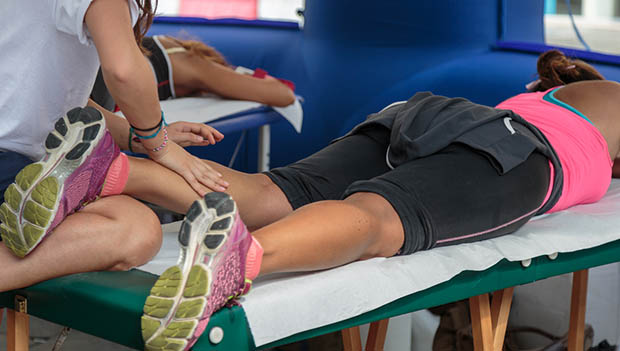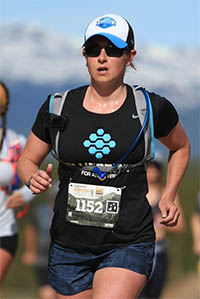
You already know you need to eat, hydrate and rest after a hard training session to get the most out of your recovery. You can go beyond that with old and new techniques to speed up recovery.
Traditional Recovery Methods for Triathletes
Not all athletes have a massage and a hyperbolic tank session after each workout. For us mere mortals, we rely on good old-fashioned tools that are useful and inexpensive to get the most out of our recovery.
Foam Roller:
One of the best tools for any athlete is the foam roller. From DIY PVC pipes to TriggerPoint Therapy Rollers, a foam roller is used to break up adhesions in your muscles and connective tissue. These 7 exercises will get you started with your new roller.
Check out our top picks for the best foam rollers out there.
Massage:
Every once in a while you should treat yourself to a massage. Look for deals on Groupon for a deep tissue or sport therapy massage. Don't schedule one immediately after a hard workout or event since your body is healing and deep tissue work is meant to break up muscle adhesions.
Not comfortable with a full massage? Try using a massage gun to get the same benefits on your own.
Contrast Shower:
If you are not much of a bath person, the contrast shower is a great tool for recovery. Alternate between hot and cold water every minute for six to eight minutes. Hot water will increase blood circulation while cold water constricts your blood vessels and decreases blood flow. The contrast of hot and cold creates a force that flushes your body of lactic acid that builds up during exercise.
New Age Athlete Recovery Services
The traditional methods for triathlon recovery are trusted and effective, however, there are some pretty great new technologies that have entered the scene recently. Learn more about each below.
Cryotherapy:
As the new mainstream trend, cryotherapy is a technique where the body is exposed to extremely cold temperatures for several minutes. Whole-body cryotherapy (WBC) benefits include decreased inflammation, as well as a boost in energy. This type of recovery has not been approved by the FDA and has little evidence to support the benefits, but it is worth a try if you don't mind the cold and have $30 to $65 for a session.
IV Therapy:
IV drips are nothing new when it comes to athletics. They are effective because they go straight to your bloodstream and bypass the digestive tract. Traditionally, they are used to help athletes recover after a marathon, an IRONMAN or even after a night of heavy drinking. You can get an IV full of nutrients and vitamins for $110 to $180, which will help you rehydrate faster.
Note: The World Anti-Doping Agency does not permit IV infusions for non-illness-related reasons, so if you are an athlete that competes at the elite level and is drug tested by USADA or WADA, check before using this method of recovery.
Fascial Stretch Therapy:
Maybe you aren't a fan of stretching out after every workout session and could use a hand with a Stretch Therapist. Fascial Stretch Therapy (FST) is a type of stretching that targets the muscles, the fascia and the connective tissue that surrounds muscles, bones and joints. Your therapist can help apply more traction, go deeper and create space in joint capsules to allow for better movement.
Cool Recovery Gadgets
Get the benefits of recovery from the comfort of your home with these cool gadgets.
Body Buffer:
These body buffers are powerful, get in tough areas and are more fun than a foam roller. If you see one at an expo, give it try. It's especially satisfying on your feet (trust us).
CBD Oil:
There are over 100 different varieties of cannabinoids. CBD oil doesn't contain any THC (the psychoactive ingredient in marijuana), so it won't cause a high and is completely legal. CBD can reduce inflammation, be used for pain management and even reduce race day stress.
Acupuncture Mat:
Lying on needles...relaxing? Yep. These acupuncture mats have thousands of very sharp, short plastic needles that you lay or sit on to relieve muscle tension. A tool like this does not do the same thing as an acupuncturist with years of training, but it does feel really good.
Recovery Shoes:
After a long run, your feet just want a spa day. When that is not in the cards, slip on recovery sandals like Oofos. Shoes like these absorb shock, provide excellent arch support and reduce the stress on your joints. Though they are not exactly stylish, your feet will thank you.
READ THIS NEXT: Determining Your Race Recovery Time
Triathlon Recovery FAQs
How do triathletes recover?
Besides using the methods above, it is important to cut training volume immediately following a triathlon. In the two weeks following your race, keep all swims at an hour or less, runs at 40 minutes or less, and bikes at 2 hours or less. If you are a seasoned triathlete, you may only need to cut volume for one week instead of two. Listen to your body and prioritize sleep.
What should you do immediately after finishing a triathlon?
As much as you’ll want to lay down, try to keep walking and stay upright. Keep your blood flowing as your heart rate comes down. In the hours following the race, active recovery workouts like aqua jogging, swimming, stationary biking, or walking (all at a very slow pace) are a good idea. A massage can also help keep blood flowing and prevent soreness the next day.
What should you eat after a triathlon?
Consume 15-25 grams of protein and 40-50 grams of carbohydrates in the half hour after completing your race. You’ll need to replenish the nutrients you lost during the triathlon.


